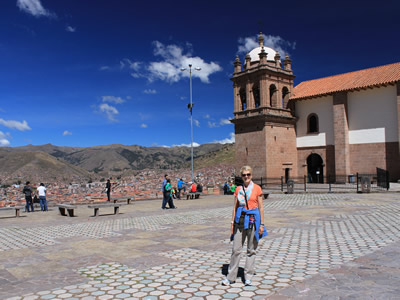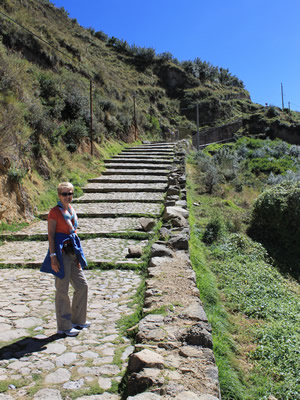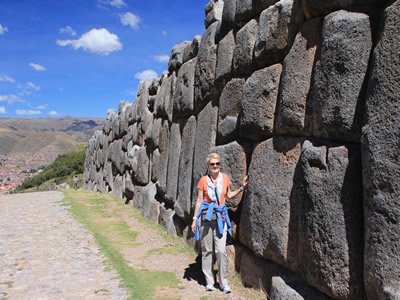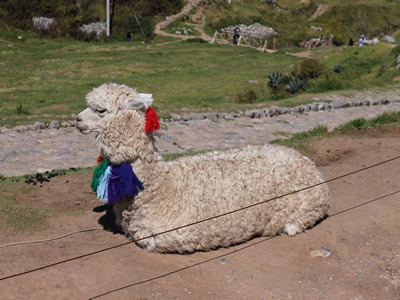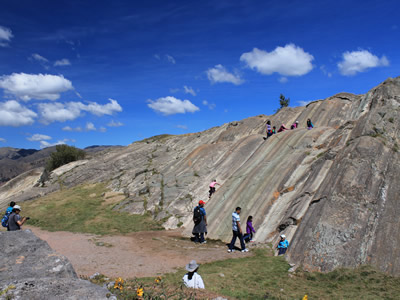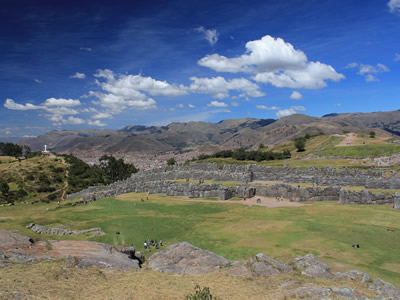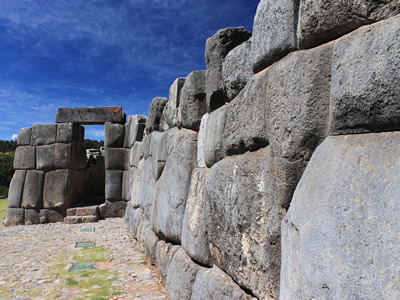Peru - Saqsaywaman
Our first day in Cusco was pretty standard. We went shopping in the San Pedro Market. We ate lunch and dinner at our hotel (both were excellent.) And since we had a very short night the day before because of our flight problems, we turned in early. But for our second day we were well rested and more ambitious. We wanted to hike to the Saqsaywaman ruins in the hills above Cusco. This is a famous Inca ruin, one of the most impressive stone walls from antiquity in all of the Americas.
It's a nice hike to reach Saqsaywaman from Cusco. From the Plaza de Armas we climbed up a series of steep, twisting streets to the church of San Cristobal. Like most Spanish buildings, the church and plaza are built on the foundations of an Inca temple. Here we were already quite a way up the hills behind the Plaza de Armas and had a nice view back down to the square and out over the rest of the city. From there we continued up another winding road until we reached a spot where an ancient Inca trail split off leading up to Saqsaywaman for people on foot. We turned off and went up the footpath. It was shorter than the road which circled around to the parking lot behind the monument. It also meant that we didn't have to dodge the traffic on the narrow street.
There was an entrance station where we had to buy a ticket to enter the archeological site. It was 70 soles each - about $50 for the two of us. There is no charge for locals. We really didn't mind. If the money was used to take care of the site (it appeared that it was) we didn't mind paying. There were good trails, a large parking lot, and even a nice bathroom (not always a given in Peru). Most importantly, the ruins themselves seemed to be well cared for.
There were lots of local vendors in the parking lot. There is no shortage of free enterprise in Peru. Some were selling souvenirs. Some were selling drinks and snacks. One guy was selling maps and guides to the ruins. I expected him to start yelling "Programs. Get your programs here!" Sandy bought a map from him. We also got drinks and a snack - it had been hard, thirsty work hiking to the ruins. There were the ubiquitous native women in traditional clothes with a llama, willing to pose for pictures for a few Soles. After I took a few sneaky pictures of one of the ladies and her llama, Sandy did pose with her and we paid for the photos.
We started at the back of the ruins. First we walked through the Chinkana, or Maze. We were in a maze of twisty little passages, all alike (sorry - just had a flashback there) through the rock formations there. Then there was a large bowl known as Muyukancha that looked a little like a Roman or Greek ampitheatre. Most scholars think that was indeed what it was used for but there are other theories as well. After the ampitheatre came the weird rock formation of the Rodadero. The face of the rock has numerous smooth grooves and there were lots of kids using them as slides. We walked up one of the shorter, less steep grooves and it was a bit of a challenge. From the top of the Rodadero we had a great view of the main walls of Saqsaywaman across an open field. So near and yet so far - the side we had to descend was quite steep and took some work to get down. Then we crossed over to look at the main attraction, the three giant walls. It's easy to understand why the Spanish originally thought that the place was built as a fortress, although now it is believed that it was actually for religious ceremonies.
The walls of Saqsaywaman are amazing. They line three terraces and the longest wall is four hundred meters long. The three walls are each about six meters high. The individual blocks are huge. The largest block on the site is estimated to weigh between one hundred and two hundred tons. These blocks were moved to the site using only ropes. Hundreds of men were required to pull a single block.
Even more amazing is the precision with which the rocks are fitted together. Although the rocks all have irregular shapes, no mortar is used to hold the wall together. The rocks fit together so precisely that there is not even enough of a gap anywhere to insert a single sheet of paper. (A standard sheet of printer paper is .1mm think - I knew that you would just have to ask.) The huge blocks were fitted using only stone carving tools. The exact technique used to make such perfect joints is not known. The effort and the patience required to make the walls must have been incredible.
Above the walls there are the foundations of several towers. They were described by the early Spanish visitors and must have been impressive. But after the conquest of Cusco the Spanish demolished the towers and used the blocks to construct their own buildings. It is said that virtually every Spanish colonial building in Cusco uses some rock cannibalized from Saqsaywaman. In fact, one of the steep streets in Cusco leading up to fortress is called Amargura, which means bitterness or sadness. The street got it's name because it was the route used to bring blocks down from Saqsaywaman to Cusco to use for construction there. There were frequent accidents and many people were killed along the way - hence the name. Although many of the Spanish colonial buildings in Cusco are hundreds of years old and very beautiful, it is sad that they destroyed much of the Saqsaywaman site to build them. It seems to be a common theme though. On our trips to Italy we saw where many ancient Roman structures were demolished and the materials used to build Christian churches in the middle ages.
Only the foundations were left so the area where the towers had been was not that impressive. The Spanish had done a good job of demolition. Besides a supply of building materials, the destruction of Saqsaywaman had a strong psychological effect on the native population. This was the scene of fighting during the revolt led by Manca Inka in 1536 when he besieged the city of Cusco. After the Spanish crushed the rebellion, they wanted to destroy anything associated with Inka history and tradition. Today the towers are completely gone. The walls were clearly too difficult to demolish.
Beyond the ruins of the towers was a viewpoint that overlooked the entire city of Cusco. Far to the south was the huge snow peak of Ausangate, at 20,945 feet it is the highest peak in the Cordillera Vilcanota and a challenging technical climb. Just east of our viewpoint was the Christo Blanco, a large white statue of Christ that overlooks the city of Cusco. It's not as impressive as the statue overlooking Rio de Janero, but it was a striking landmark at night when it was lit up and clearly visible from the Plaza de Armas.
When we had walked all around Saqsaywaman we headed over to the Christo de Blanco. From the parking lot we dropped down to the low point between the two hills and then climbed up a steep path to the statue. There were several other archeological sites nearby and our guidebook described a hiking route to tour them all. But it was already mid afternoon and we wanted to get back to Cusco. We wanted lunch, and after that we wanted to do more shopping at the market. So we headed back down to town.
As we were hiking down the trail two young American women were hiking up. As we reached them they stopped and one asked "Is this the way to Cinco de Blanco?". I'm no Spanish whiz but even I was like, WTF? Huh? Finally it dawned on me. "Do you mean, is this the way to Christo de Blanco?". "Oh. Yeah. That's what I meant." I said yes. Sandy and I rolled our eyes and continued back towards town. When I got back to work in Boise after the trip I told the story to my friend Ivan, who grew up in Mexico, and he thought it was hilarious.
By the time we got back to the Plaza de Armas it was about two oclock and we were really hungry. We went to the Papillion Restaurant, at the northeast corner of the square on the second floor. We got a table on their balcony with a beautiful view of the plaza and had a wonderful lunch. It would have been perfect except that when we tried to pay with a credit card it wouldn't go through, even though they tried multiple times. Finally we pooled our cash and found out that we had just barely enough Peruvian money to pay for our lunch. Good thing as I really wasn't anxious to spend the rest of the day doing dishes. Unfortunately when we checked later we found out that the credit card charge had in fact gone through. So we paid for lunch twice. It was only about thirty dollars so we decided that if that was the worst thing that happened on the trip, we were probably ok.
Then it was on to the market for more shopping!
Final note. If at the end of this post you are still struggling with how to pronounce the name of the archaeological site, Saqsaywaman, just use the joke that every tourist guide tells. Say "sexy woman" and it will be close enough. Everyone will know what you mean.
